
What is White Box Testing? Techniques, Examples and Types
July 17th, 2023
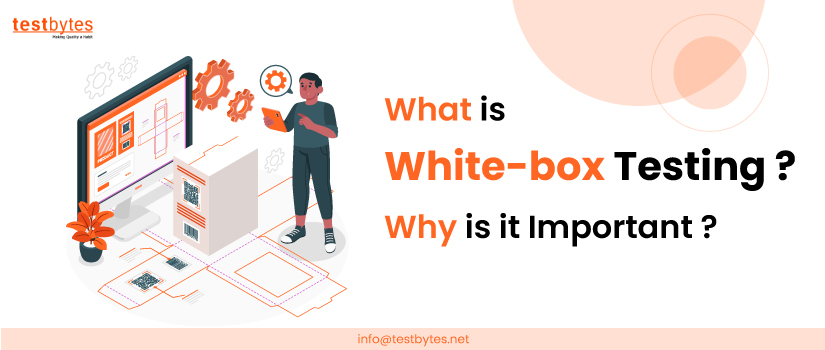
The significance of guaranteeing the quality and dependability of applications cannot be overstated in the fast-paced world of software development.
This is where White Box Testing comes in, a potent process that probes deeply into the inner workings of software to reveal possible faults and vulnerabilities.
By examining its different methods and examples, we will demystify the idea of white box testing in this extensive blog article.
Join us on this trip as we shed light on the many forms of White Box Testing and how they play a critical part in enhancing software quality and security—from comprehending the basic concepts to uncovering its practical implementations.
This article will provide you priceless insights into the realm of White Box Testing, whether you’re an experienced developer or an inquisitive tech enthusiast.
What is White Box Testing With an Example?
White Box Testing is also known by other names such as:
- Clear Box Testing
- Transparent Box Testing
- Glass Box Testing
- Structural Testing
- Code-Based Testing
White Box Testing is a software testing process that includes studying an application’s core structure and logic. It is carried out at the code level, where the tester has access to the source code and is knowledgeable of the internal implementation of the product.
White Box Testing, as opposed to Black Box Testing, which focuses on exterior behavior without knowledge of the underlying workings, tries to guarantee that the code performs as intended and is free of mistakes or vulnerabilities.
This testing method gives useful insights into the application’s quality and helps discover possible areas for development by studying the program’s structure, flow, and pathways.
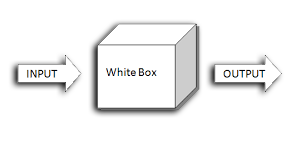 In white box testing, the tester has to go through the code line by line to ensure that internal operations are executed as per the specification and all internal modules are properly implemented.
In white box testing, the tester has to go through the code line by line to ensure that internal operations are executed as per the specification and all internal modules are properly implemented.
Example
Let’s consider a simple example of white box testing for a function that calculates the area of a rectangle:
def calculate_rectangle_area(length, width):
if length <= 0 or width <= 0:
return “Invalid input: Length and width must be positive numbers.”
else:
area = length * width
return area
Now, let’s create some test cases to perform white box testing on this function:
Test Case 1: Valid Input
- Input: length = 5, width = 3
- Expected Output: 15
Test Case 2: Invalid Input (Negative Value)
- Input: length = -2, width = 4
- Expected Output: “Invalid input: Length and width must be positive numbers.”
Test Case 3: Invalid Input (Zero Value)
- Input: length = 0, width = 6
- Expected Output: “Invalid input: Length and width must be positive numbers.”
Test Case 4: Valid Input (Floating-Point Numbers)
- Input: length = 4.5, width = 2.5
- Expected Output: 11.25
Test Case 5: Valid Input (Large Numbers)
- Input: length = 1000, width = 10000
- Expected Output: 10,000,000
In this situation, white box testing entails analyzing the function’s core logic and creating test cases to make sure all code paths are covered.
In order to determine if the function operates as intended in various contexts, test cases are designed to assess both valid and invalid inputs.
White box testing allows us to both confirm that the function is correct and find any possible defects or implementation problems.
White Box Testing Coverage
#1) Code level: Errors at the source code level, such as syntax mistakes, logical mistakes, and poor data handling, are found using white box testing.
#2) Branch and Path Coverage: By making sure that all potential code branches and pathways are checked, this testing strategy helps to spot places where the code doesn’t work as intended.
#3) Integration Issues: White box testing assists in identifying problems that may develop when several code modules are combined, assuring flawless system operation.
#4) Boundary Value Analysis: White box testing exposes flaws that happen at the boundaries of variable ranges, which are often subject to mistakes, by examining boundary conditions.
#5) Performance bottlenecks: By identifying regions of inefficient code and performance bottlenecks, engineers are better able to improve their products.
#6) Security issues: White box testing reveals security issues, such as errors in input validation and possible entry points for unauthorized users.
White Box Testing’s Role in SDLC and Development Process.
White box testing is necessary for the Software Development Life Cycle (SDLC) for a number of crucial reasons.
White box testing, sometimes referred to as clear box testing or structural testing, includes analyzing the software’s core logic and code. This testing technique may be used to find a variety of flaws and problems, including:
Code-level Errors: White box testing uncovers issues at the source code level, such as syntax errors, logical errors, and improper data handling.
Branch and Path Coverage: This testing approach ensures that all possible branches and paths within the code are tested, helping identify areas where the code doesn’t function as intended.
Integration Problems: White box testing aids in detecting issues that may arise when different code modules are integrated, ensuring seamless functioning across the entire system.
Boundary Value Analysis: By exploring boundary conditions, white box testing reveals bugs that occur at the limits of variable ranges, which are often prone to errors.
Performance Bottlenecks: It helps pinpoint performance bottlenecks and areas of inefficient code, allowing developers to optimize the software for better performance.
Security Vulnerabilities: White box testing exposes security vulnerabilities, such as input validation flaws and potential points of unauthorized access.

Difference Between White Box Testing and Black Box Testing
Both of them are two major classifications of software testing. They are very different from each other.
- White box testing refers to the line-by-line testing of the code, while black box testing refers to giving the input to the code and validating the output.
- Black box testing refers to testing the software from a user’s point of view, whereas white box testing refers to the testing of the actual code.
- In Black box testing, testing is not concerned about the internal code, but in WBT, testing is based on the internal code.
- Both the developers and testers use white-box testing. It helps them validate the proper functioning of every line of the code.
| Aspect | Black Box Testing | White Box Testing |
| Focus | Tests external behavior without knowledge of code | Tests internal logic and structure with knowledge of the source code |
| Knowledge | No access to the internal code | Access to the internal code |
| Approach | Based on requirements and specifications | Based on code, design, and implementation |
| Testing Level | Typically done at the functional and system level | Mostly performed at the unit, integration, and system level |
| Test Design | Test cases based on functional specifications | Test cases based on code paths and logic |
| Objective | Validate software functionality from the user’s perspective | Ensure code correctness, coverage, and optimal performance |
| Testing Types | Includes Functional, Usability, and Regression Testing | Includes Unit Testing, Integration Testing, and Code Coverage |
| Tester’s Knowledge | Testers don’t need programming expertise | Testers require programming skills and code understanding |
| Test Visibility | Tests the software from an end-user perspective | Tests the software from a developer’s perspective |
| Test Independence | Testers can be independent of developers | Testers and developers may collaborate closely during testing |
| Test Maintenance | Requires fewer test case modifications | May require frequent test case updates due to code changes |
Steps to Perform White Box Testing
Step #1 – Learn about the functionality of the code. As a tester, you have to be well-versed in programming language, testing tools, and various software development techniques.
Step #2– Develop the test cases and execute them.
Types of White Box Testing/Techniques Used in White Box Testing
The term “white box testing,” also known as “clear box testing” or “structural testing,” refers to a variety of testing methods, each with a particular emphasis on a distinct element of the core logic and code of the product. The primary categories of White Box Testing are as follows:
Statement coverage testing
During the testing process, this approach seeks to test every statement in the source code at least once.
Example:
@startuml
title Statement Coverage Testing
actor Tester as T
rectangle Program {
rectangle Code {
T -> C : Test Case 1
T -> C : Test Case 2
T -> C : Test Case 3
T -> C : Test Case 4
}
rectangle Execution {
C -> E : Execute Test Case 1
C -> E : Execute Test Case 2
C -> E : Execute Test Case 3
C -> E : Execute Test Case 4
}
}
@enduml
Branch coverage testing
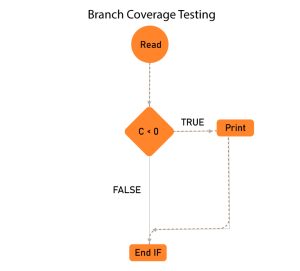
Testing for branches or decision points is known as branch coverage, and it makes sure that every branch or decision point in the code is tested for both true and false outcomes.
Path coverage testing
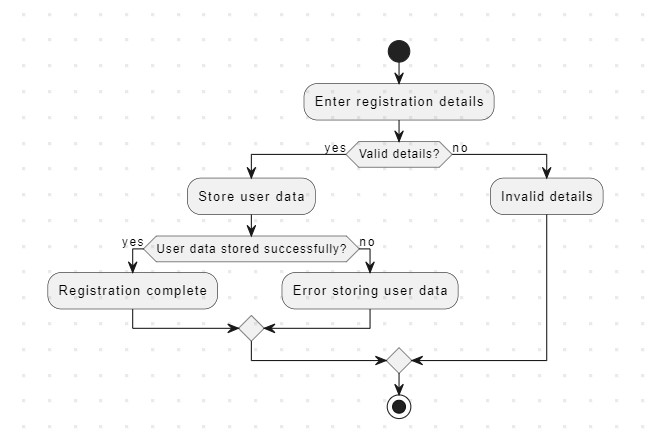
Path coverage testing is a software testing technique that ensures that all possible execution paths through the source code of a program are tested at least once. It aids in the identification of potential defects or issues in the code by ensuring that every logical path is tested.
Example:
Suppose you have a program with a conditional statement:
python
Copy code
if x > 5: print(“x is greater than 5”) else: print(“x is not greater than 5”)
Path coverage testing would involve testing both paths through this code:
- When x is greater than 5, it should print “x is greater than 5.”
- When x is not greater than 5, it should print “x is not greater than 5.”
Condition coverage testing
The goal of condition coverage testing, commonly referred to as “decision coverage,” is to make sure that all potential outcomes of boolean conditions inside the code are evaluated at least once. This method aids in ensuring that every choice or branch in the code gets executed on its own.
Example:
| def check_voting_eligibility(age, is_citizen):
if age >= 18 and is_citizen: return “You are eligible to vote.” else: return “You are not eligible to vote.” In this example, the function check_voting_eligibility takes two parameters: age (an integer) and is_citizen (a boolean). It then checks whether a person is eligible to vote by evaluating two conditions: whether their age is 18 or older and whether they are a citizen. To achieve condition coverage testing, we need to create test cases that cover all possible combinations of conditions and their outcomes. Here are some example test cases: Test case where the person is eligible to vote: assert check_voting_eligibility(20, True) == “You are eligible to vote.” Test case where the person is not a citizen:
assert check_voting_eligibility(25, False) == “You are not eligible to vote.” Test case where the person is not old enough to vote: assert check_voting_eligibility(15, True) == “You are not eligible to vote.” Test case where both conditions are false: assert check_voting_eligibility(12, False) == “You are not eligible to vote.” By designing these test cases, we ensure that all possible combinations of condition outcomes are covered:
When executing these test cases, we can determine if the function behaves as expected for all possible combinations of input conditions. This approach helps identify potential bugs or inconsistencies in the code’s logic related to condition evaluation. |
Loop Coverage Testing
Testing loops in the code to make sure all conceivable iterations are carried out is the subject of the loop coverage testing approach.
Let’s consider an example of loop coverage testing using a simple program that calculates the factorial of a given number using a for loop:
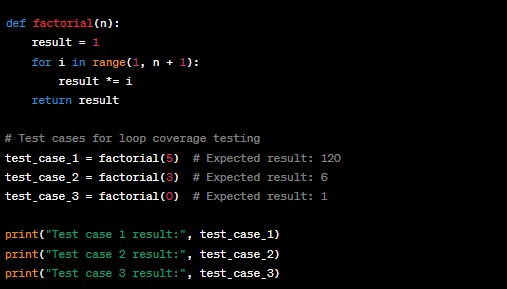
In this example, the ‘factorial’ function calculates the factorial of a given number using a ‘for’ loop. Loop coverage testing aims to test different aspects of loop behavior. Here are the scenarios covered:
Test case 1: Calculating the factorial of 5. The loop runs from 1 to 5, multiplying result by 1, 2, 3, 4, and 5. The expected result is 120.
Test case 2: Calculating the factorial of 3. The loop runs from 1 to 3, multiplying result by 1, 2, and 3. The expected result is 6.
Test case 3: Calculating the factorial of 0. Since the loop’s range is from 1 to 0+1, the loop doesn’t execute, and the function directly returns 1.
Boundary Value Analysis
It evaluates how the program behaves at the border between acceptable and unacceptable input ranges.
Data flow testing
Data flow testing looks at how data moves through the program and confirms that data variables are handled correctly.
Control flow testing:
Control flow testing analyzes the order of the statements in the code or the control flow.
Testing using Decision Tables
Based on predetermined criteria, decision tables are used to test different combinations of inputs and their related outputs.
Mutation Testing
In order to determine how well the test suite is able to identify these alterations, mutation testing includes making minor modifications or mutations to the code.
These numerous White Box Testing approaches are used to test the underlying logic of the program thoroughly and achieve varying degrees of code coverage. Depending on the complexity of the product and the testing goals, testers may combine various approaches.
Top White Box Testing Tools
#1) Veracode
Veracode is a prominent toolkit that helps in identifying and resolving the defects quickly, economically and easily. It supports various programming languages like .NET, C++, JAVA, etc. It also supports security testing.
#2) EclEmma
EclEmma is a free Java code coverage tool. It has various features that ease the testing process. It is widely used by the testers to conduct white box testing on their code.
#3) JUnit
JUnit is a widely-used testing framework for Java that plays a crucial role in automating and simplifying the process of unit testing. It provides a platform for developers to write test cases and verify their Java code’s functionality at the unit level. JUnit follows the principles of test-driven development (TDD), where test cases are written before the actual code implementation.
#4) CppUnit:
CppUnit is a testing framework for C++ that was created to facilitate unit testing for C++ programs. It is based on the design concepts of JUnit. It allows programmers to create and run test cases to verify the accuracy of their C++ code.
#5) Pytest
This C++ test framework by Google has an extensive list of features including test Discovery, Death tests, Value-parameterized tests, fatal & non-fatal failures, XML test report generation, etc. It supports various platforms like Linux, Windows, Symbian, Mac OS X, etc.
Advantages of White Box Testing
- Code optimization
- Transparency of the internal coding structure
- Thorough testing by covering all possible paths of a code
- Introspection of the code by the programmers
- Easy test case automation
Disadvantages of White Box Testing
- A complex and expensive procedure
- Frequent updating of the test script is required whenever changer happens in the code
- Exhaustive testing for large-sized application
- Not always possible to test all the conditions.
- Need to create a full range of inputs making it a very time-consuming process

Conclusion
White box testing is a predominantly used software testing technique. It is based on evaluating the code to test which line of the code is causing the error. The process requires good programming language skills and is generally carried out by both developers and testers.
FAQs
#1) How can developers ensure adequate code coverage when performing White Box Testing?
By using a variety of techniques, developers may guarantee proper code coverage in White Box Testing.
They should start by clearly defining test goals and requirements, making sure that all crucial features are included. It is best to write thorough test cases that cover all potential outcomes, including boundary values and error handling.
To track the amount of code that is exercised by tests, code coverage tools like Jacoco or Cobertura may be utilized. It is crucial to remedy low-coverage regions by adding test cases or making adjustments after regularly analyzing code coverage metrics to do so.
To carry out thorough testing effectively, test automation should be used, and branch and path coverage guarantees that all potential choices and code routes are checked.
Working together with the QA team ensures thorough integration of White Box and Black Box Testing. Developers may improve code quality and lower the chance of discovering bugs by adhering to certain best practices.
#2) What are some best practices for conducting effective White Box Testing in a development team?
Effective White Box research Following various best practices is necessary while testing in a development team. Here are a few crucial ones:
Clear needs: As this information informs test case creation, make sure that the team has a complete grasp of the functional and non-functional needs for the project.
Comprehensive Test Cases: Create detailed test cases that cover all possible code pathways, decision points, and boundary conditions. This will guarantee complete code coverage.
Code reviews: These should be conducted on a regular basis to guarantee code quality, spot possible problems, and confirm that tests are consistent with code changes.
Test Automation: Use test automation to run tests quickly and reliably, giving you more time for exploratory testing and a lower risk of human mistakes.
Continuous Integration: Include testing in the process to spot problems before they become serious and to encourage routine code testing.
Test Data Management: To achieve consistent and reproducible test findings, test data should be handled with care.
Code coverage : metrics should be regularly monitored in order to identify places with poor coverage and focus testing efforts there.
Collaboration with QA Team: Encourage cooperation between the QA team and the developers to make sure that all White Box and Black Box Testing activities are coordinated and thorough.
Regression testing: Regression testing should be continuously carried out to ensure that new code modifications do not cause regressions or affect working functionality.
Documentation: Test cases, processes, and results should all be well documented in order to encourage team collaboration and knowledge sharing.
#3) What is the black box testing?
Black box testing is a software testing method where the internal workings or code structure of a system are not known to the tester. The focus is solely on validating the system’s functionality against specified requirements.
Testers input data, observe outputs, and assess the system’s behavior without knowledge of its internal logic. This approach mimics user interactions, ensuring that the software performs as expected from an end-user perspective. Black box testing is crucial for uncovering defects, ensuring software reliability, and validating that the application meets user expectations without delving into the intricacies of its internal design.
The four main types of black box testing are Functional Testing, Non-functional Testing, Regression Testing, and User Acceptance Testing. Functional Testing assesses specific functionalities, Non-functional Testing evaluates non-functional aspects like performance, Regression Testing ensures new changes don’t impact existing features, and User Acceptance Testing verifies if the system meets user expectations.


 Software Testing Events
Software Testing Events App Testing
App Testing Web App Testing
Web App Testing Game Testing
Game Testing Automation Testing
Automation Testing Load Testing
Load Testing Security Testing
Security Testing Performance Testing
Performance Testing Hire a Tester
Hire a Tester





